
A spitting cobra can deliver venom either through a bite or by ejecting it from its fangs.Credit: BlackBoxGuild/Creatas/Getty
Venomous snakes bite millions of people every year, most of them in India. Ravikar Ralph, a physician at the Christian Medical College Vellore hospital in India, is one of the people who treats them.
The hospital, one of just nine poison-control centres in India, sees about 200 people who are gravely ill after a snakebite each year. They arrive with a variety of symptoms. Bites from venomous snakes called vipers can cause bleeding and tissue damage that is severe enough to require amputation. The venom of kraits (Bungarus spp.) induces abdominal pain and progressive paralysis. One of Ralph’s patients, a farmer, spent 71 days in hospital after being bitten by an Indian cobra (Naja naja). He had to undergo dialysis because his kidneys began to fail. A subsequent heart attack required him to be resuscitated. “The bite nearly took his life,” Ralph says. The farmer was lucky. Every year, around an estimated 63,000 people die from snakebites worldwide (see ‘Snakebite mortality’).
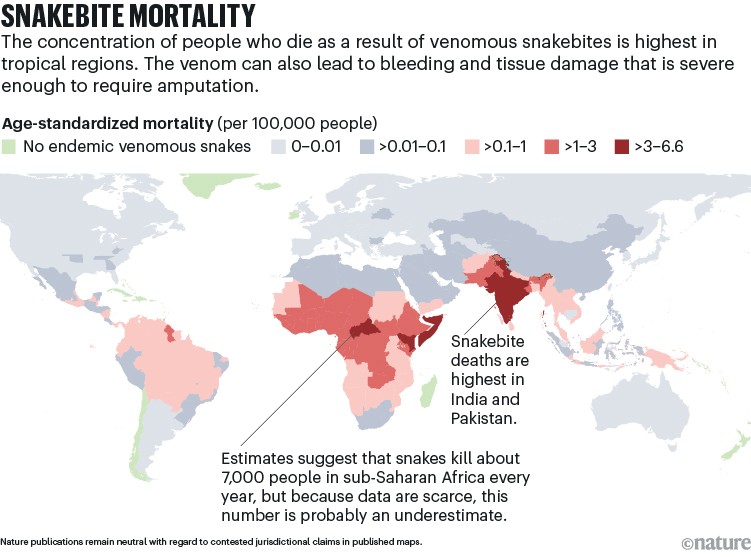
Source: GBD 2019 Snakebite Envenomation Collaborators. Nature Commun. 13, 6160 (2022). Map credit: Alisdair Macdonald
Antivenom is the only approved therapy for snakebites. It’s produced in much the same way as it was 100 years ago. Small, non-lethal amounts of snake venom are injected into animals such as horses, which then produce antibodies that are collected from the animals’ blood. Antivenom saves lives, especially when it is administered soon after the bite.
But this treatment is hard to come by in the rural areas where most bites occur. And it has a number of serious drawbacks. To maximize effectiveness, it is almost always given intravenously. And in most cases, antivenom only works against the specific snake venom that was used to produce it. A horse injected with venom from a black mamba (Dendroaspis polylepis), for example, won’t produce antibodies that work against cobra venom. According to one study1, there are 127 antivenoms on the market.

Part of Nature Outlook: Neglected tropical diseases
What’s more, because antivenom comes from animals, it sometimes causes severe immune reactions. “All of those deficiencies mean that there’s a really strong rationale to try and improve treatment and to develop new therapies that can address some of those challenges,” says Nicholas Casewell, a venom biologist at the Liverpool School of Tropical Medicine, UK.
An ideal therapy to counteract venomous snakebites would be easy to administer and work against a wide range of species. Researchers have made significant headway towards these goals in the past several years. They’re testing repurposed medications in clinical trials, discovering drug targets in snake venom and developing antibodies that seem to counteract venom, at least in animal models. Eventually, they aim to combine these next-generation therapies into cocktails that will be effective against venoms from many species of snake. But for these therapies to reach the people who need them most, they also have to be affordable.
Timely treatment
Snakebites are so deadly, in part, because the people who are bitten often live far from the nearest supply of antivenom. Because of the need for intravenous delivery and the risk of severe side effects, it’s typically available only in hospitals. Unfortunately, many people who are bitten never make it there. Or, if they do, by the time they arrive the damage is so widespread that antivenom doesn’t provide much benefit. That’s why researchers have long hoped to find medications that can be given soon after the bite occurs, even before the person arrives at a hospital.
The task is trickier than it sounds. Snake venoms are complex concoctions that consist of dozens of toxins. Exactly what they contain varies not just between species, but also within the same species. The good news is that only a handful of toxin families in snake venom are deadly to humans. Researchers have already identified medicines that seem to target three of these. Because these are existing medications — pills or injectables — they don’t have to start the drug-development process from scratch. And that should keep costs down.
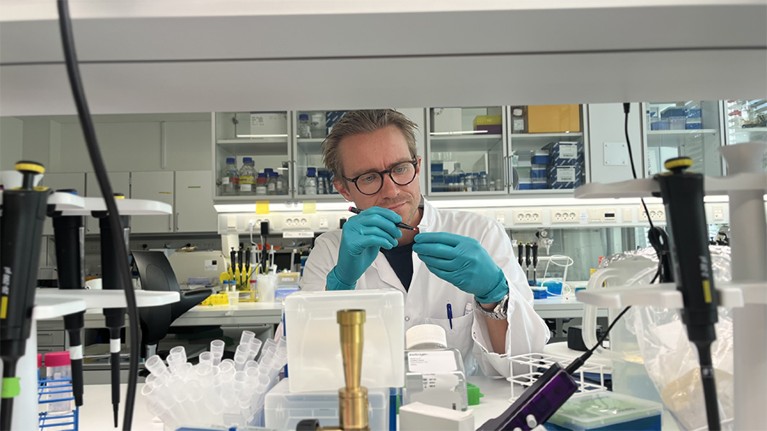
Antibody researcher Andreas Laustsen-Kiel marks samples in his laboratory at the Technical University of Denmark in Kongens Lyngby.Credit: Emily Urvi Glegg-Sørensen
Matthew Lewin, an emergency-medicine physician and neuroscientist based in California, began developing treatments for snakebite more than a decade ago. He was putting together field kits for a California Academy of Sciences’ expedition to the Philippines and lamenting the fact that he didn’t have much to offer. Antivenom is difficult to administer in the field.
Lewin thought he might be able to find an existing medication that could serve as a therapy, ideally something that wouldn’t need to be injected, such as a pill. “You can take them orally, they get out into the circulation fast, they can penetrate tissues that the antivenom can’t,” he says. But he didn’t make much progress on the project until a chance encounter at a house party in California. Former Talking Heads guitarist and technology investor Jerry Harrison happened to be there, and he asked “Does anybody have any crazy ideas that are lying fallow?” Lewin jumped at the chance to share his vision for a snakebite therapy. Harrison was intrigued.
In 2015, the pair co-founded biotechnology firm Ophirex in Corte Madera, California. The company is focusing on an anti-inflammatory drug, called varespladib, that had been tested in more than 2,500 people with heart problems. It was never approved because it didn’t seem to help the heart. But in experiments that began in Lewin’s garage, he discovered that varespladib does seem to inhibit a family of enzymes called secretory phospholipases A2 (sPLA2), toxins that are found in the venom of 95% of venomous snakes. “That’s really the venom component that’s likely to kill you,” he says.
In 2021, Ophirex started human trials on the drug to treat snakebite. The company’s first study enrolled 95 individuals in India and the United States who had been bitten by any venomous snake within the previous ten hours2. All of these individuals received the standard of care, including antivenom. Around half received varespladib, and the remainder received a placebo. Individuals who received the drug didn’t fare any better than those who didn’t. Both groups experienced about the same amount of improvement in the hours after initiating the study. But Lewin says that there are hints that varespladib does what it is intended to do if given soon after the bite. When the researchers looked at individuals who were enrolled in the study within five hours of being bitten, they found that the varespladib group fared slightly better by some measures, although the differences were not statistically significant. That suggests that the pill, if given quickly, might buy people more time to reach the hospital, offering them what Lewin calls “a bridge to survival”.
Lewin hopes that a second study that will wrap up soon will provide a more definitive answer to whether varespladib works as intended to inhibit the effects of venom sPLA2s. In this trial, researchers are administering the drug intravenously so that it enters the bloodstream quickly. Giving a drug in this way isn’t practical in the field, but Lewin hopes that it might help to demonstrate the drug’s efficacy.
Casewell and his colleagues are hoping to repurpose a different oral medication to treat snakebites. Unithiol is used to treat heavy-metal poisoning. It binds to metal ions and neutralizes them until they can be excreted in urine. In people who have been bitten by a snake, unithiol disables metalloproteinase enzymes, which are among the most common and deadly groups of toxins found in the venom of many vipers. These enzymes cause a host of problems, including bleeding. Unithiol works by mopping up the zinc ions that this group of enzymes needs to function.
Experiments in animals have been encouraging. The gold-standard test for antivenom therapies involves mixing the therapy with a lethal dose of snake venom and delivering it intravenously to mice. In that scenario, unithiol worked. But increasingly, researchers are using ‘rescue’ models that more closely mimic what happens in real life. The venom is administered first, followed by the therapy. Casewell and his colleagues injected mice with a lethal dose of venom from a West African saw-scaled viper (Echis ocellatus) and then gave the mice unithiol, antivenom or both. Unithiol performed about as well as antivenom, and all the mice that received unithiol 15 minutes after an injection of the venom, and then conventional antivenom after one hour, survived for 24 hours — the end of the experiment3.
Casewell’s group has already moved unithiol into safety trials in humans. It tested varying doses of the treatment in adults in Kenya who were healthy and who had not been bitten by a snake4. Casewell has secured funding for an efficacy trial, which he hopes to start soon.
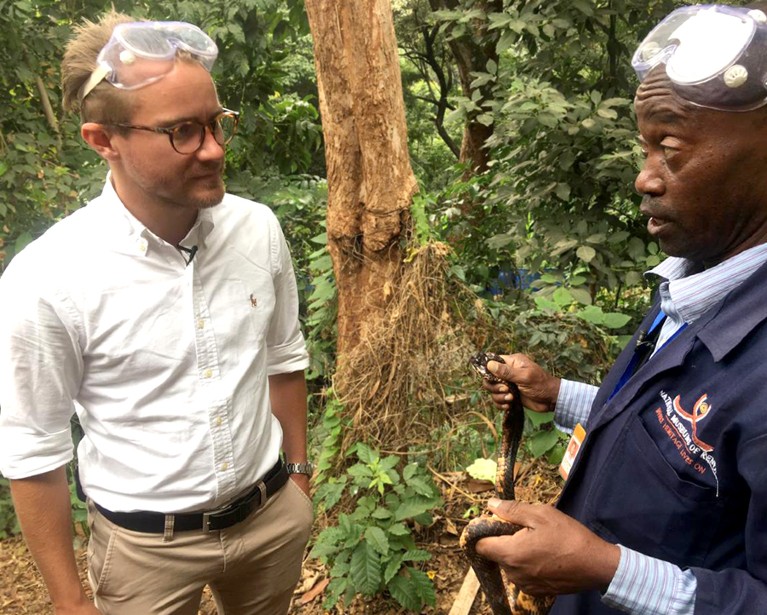
Antibody researcher Andreas Laustsen-Kiel (left) talks to a staff member at the Nairobi Snake Park who is holding a species of African cobra.Credit: Andreas Laustsen-Kiel
Further work by Casewell and his colleagues suggests a common blood thinner can act against a third family of toxins, known as three-finger toxins5. The researchers used CRISPR gene-editing technology to develop a pool of human cells that had a variety of single genes inactivated. They then exposed these cells to venom from two species of spitting cobra (a bite from these snakes can cause massive tissue death). The screen helped the researchers to understand which components of the cells are required for the venom to cause cell death. Production of sugar molecules seems to be key. Cells that lacked these genes were resistant to the venom’s toxic effects. The researchers wondered whether they could use a molecule shaped like these sugars, such as the common blood thinner heparin, to bind to the toxins and prevent them from causing damage. It worked. In mice, a heparin-like drug called tinzaparin curbed local tissue damage after the rodents were injected with spitting cobra venom.
“This specific type of toxin can do some really nasty damage to your tissue,” says Steven Hall, one of the co-authors and a pharmacology researcher at Lancaster University, UK. “So having something that can target those toxins is potentially very powerful.”
Casewell agrees that these blood thinners are “readily available, they’re inexpensive, they’ve been licensed for a long time, and they have very well-defined safety profiles”, he says. And because they’re safe and can be injected under the skin, they could be used in the communities in which people get bitten, perhaps with the help of a pharmacist. The hope is that they would stave off tissue damage, giving an individual more time to reach hospital.
Each of these drugs could prove valuable, and the next step is to get them approved individually for snakebites. But most researchers expect that the best drug therapies will be cocktails that target multiple toxins. Last year, Hall, Casewell and their colleagues reported that injecting varespladib with either unithiol or marimistat, another drug that targets metalloproteinases, drastically reduced tissue death caused by viper venom in mice6. The combination worked even when delivered an hour after the venom was injected. “We were just like, ‘Holy crap, this is fantastic!’” Hall says. The team tested venoms from vipers in Central America, the United States and West Africa. The combination worked against all of them.
Hall is already thinking about possible combinations. “We now have [drug candidates] that can target at least these three different major toxin families,” he says. “You would have a hard time finding any snake venom that doesn’t contain at least one of those families as a major component.”
Antibody antidote
Although small molecules such as varespladib could prove valuable, they aren’t likely to replace antivenom. So, many researchers are working to overhaul a therapy they already know is effective: antibodies.
“Existing antivenoms are based on antibodies,” says Andreas Laustsen-Kiel, an antibody researcher at the Technical University of Denmark in Kongens Lyngby. “They work. They neutralize venom toxins.” But each product typically works only on a handful of species. Researchers hope to find more universal antibodies that act against a range of snake venoms and then produce them in the lab. Like conventional antivenom, lab-made antibodies are administered intravenously. But the hope is that they would be simpler to produce and less likely to cause an allergic reaction.
Joseph Jardine, an immunologist at Scripps Research in La Jolla, California, has spent much of his career working on HIV. He first stumbled into developing snakebite therapies in 2020. At the time, he was working for a non-profit organization that develops vaccines for infectious diseases. He knew little about snakes. But the basic problem seemed familiar: how do you develop antibodies that will neutralize a target that has an enormous amount of variability? “This is almost exactly the same situation as HIV,” he says. In both cases, the solution is to develop antibodies that bind to the parts that are conserved — the structures of the target that are so crucial they can’t change.
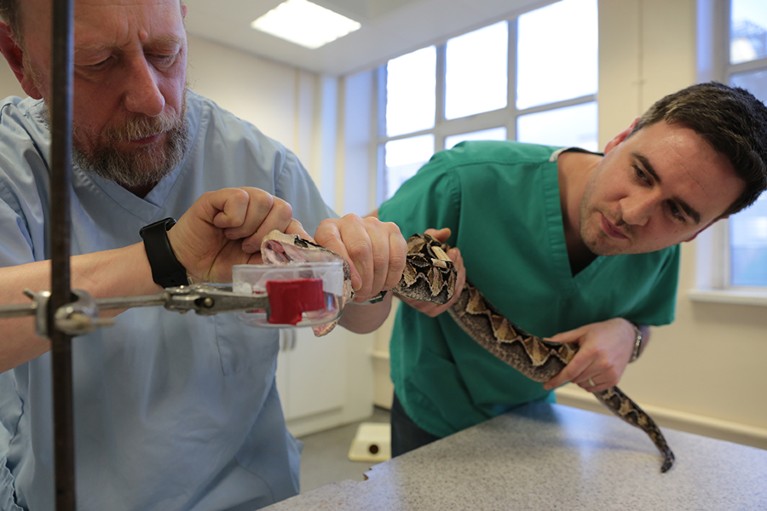
Venom biologist Nick Casewell (right) helps to extracts venom from a Gaboon viper (Bitis gabonica).Credit: Kirstin Kidd
Jardine and his colleagues are focusing first on three-finger toxins. They created a synthetic version and then searched a library of 50 billion human antibodies to look for anything that might bind to it. They found several thousand promising candidates and further winnowed their list down to 30 by testing them against three-finger toxins from 4 species of snake. One clear winner stood out: an antibody called 95Mat5. This antibody, administered 10 or 20 minutes after mice were dosed with venom from a black mamba or monocled cobra (Naja kaouthia), rescued the rodents from the neurotoxic effects of the three-finger toxins. All of the mice treated with 95Mat5 survived for 24 hours, the end of the observation period. Mice that didn’t receive the antibody died within three hours7.
Now, Jardine and his colleagues are searching for antibodies that work as well against the other families of toxins. “The dream that we have is to be able to replace the current antivenoms with four or five really good, broadly neutralizing monoclonal antibodies,” he says.
Lab-made human antibodies aren’t cheap to produce, however. So Laustsen-Kiel and his colleagues have started pursuing a different kind of therapy. Rather than creating human antibodies, they’re developing nanobodies: a much smaller type of antibody produced by animals such as llamas and alpacas (see ‘The nanobody alternative’). Nanobodies are less complex than antibodies, so they can be produced in the lab using organisms such as yeast or Escherichia coli, making them significantly less expensive. “You can likely go an order of magnitude down in cost of manufacturing,” Laustsen-Kiel says. And they’re “super stable”, he adds. “You can heat them up, almost boil them, and they stay intact.”
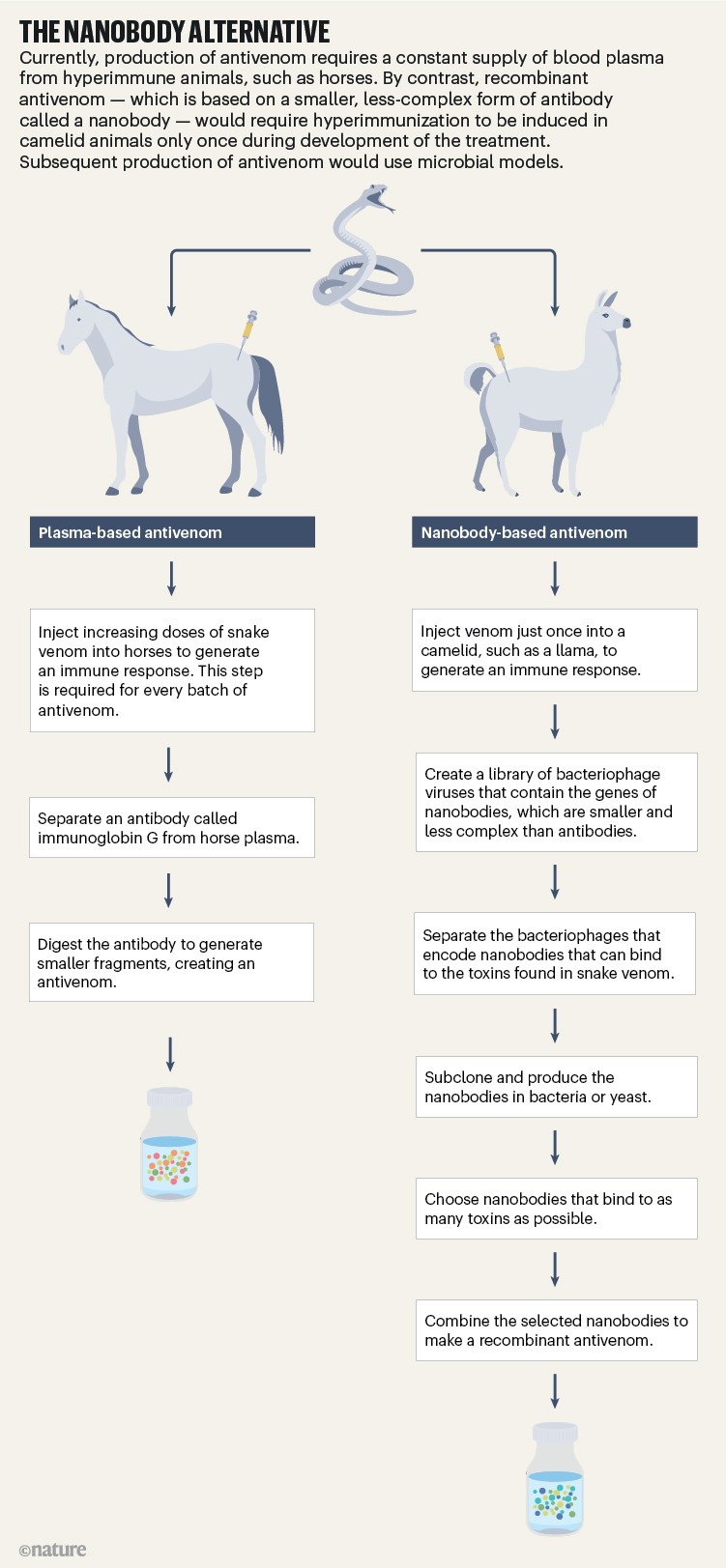
Credit: Alisdair Macdonald
To identify nanobodies that might bind to important toxins, Laustsen-Kiel and his colleagues first injected small amounts of venom from 18 mamba and cobra species into alpacas and llamas. Then they harvested the antibody-creating white cells from the animals’ blood. Next, they took the genes from these cells and expressed them in bacteriophages — viruses that infect bacteria. “You have a link between the protein and its DNA,” he says. “So essentially, the phage with the DNA becomes a barcode.”
Once this nanobody library was in place, the team began searching for nanobodies that could bind to the most medically important toxins in the venom of African snakes. That work has yet to deliver results, but the researchers have discovered nanobodies that are capable of neutralizing two of the toxin families produced by coral snakes (Micruroides sp. and Micrurus sp.), which are found in the Americas and are distantly related to mambas and cobras. The two nanobodies combined offered good protection against venoms from two species of coral snake8.
“People in the past, they thought that you would need hundreds of antibodies because you have technically hundreds of medically relevant toxins,” Laustsen-Kiel says. “But if you’re smart in your design, you can actually neutralize these venoms with quite simple mixtures that are feasible to manufacture.”
Other groups are designing toxin blockers from scratch, without the need for horses, humans or alpacas. In a preprint posted in May9, researchers led by biochemist David Baker at the University of Washington in Seattle, who also won a share of the Nobel Prize in Chemistry this year, used deep-learning models to create ‘mini-protein binders’. These tiny proteins act like antibodies and can bind to three-finger toxins. When the researchers produced two of these proteins and tested them in mice, they found that they offered good protection against the toxins. When they gave mice these mini-proteins 15 minutes after they received the toxins, all the mice survived9.
Even after 30 minutes, both mini-proteins showed good protection. “That doesn’t mean that they’re going to translate into a therapy,” Casewell says. “But I think what is interesting is the potential speed with which new molecules could be discovered using this approach.” Researchers can design proteins that bind tightly to specific toxins without having to screen antibody or nanobody libraries.
The method offers other theoretical advantages, too. Because these proteins are smaller than antibodies, they might be able to penetrate deeper into tissues. They would also be inexpensive to produce.
Ralph, who sees the devastating impact of snakebites each day in India, is excited that researchers are making progress towards new therapies. But he also sees a wide gap between these therapies and the current standard of care. And sometimes it’s difficult to see how that gap can be bridged. Snakebite is a disease associated with poverty. The health-care systems in many of the countries most affected are struggling, Ralph says. He recommends that “the focus should be on strengthening what currently exists”. Therapies that are more effective or more convenient will only be useful if they are also affordable and accessible to the people who need them most. It’s a conundrum common to all neglected tropical diseases, and one with no obvious solution.






